Some hobbyists have a refugium, whereas some prefer to use a sump. Many have never heard of aquarium sumps and refugiums at all, and may be wondering which is the best choice for their setup. But did you know that the best option for peak filtration system performance is to install both?
So, how does a refugium work, and what’s the difference between the two?
Read our guide to refugium vs. sump and you’ll learn everything you need to know!
What Is An Aquarium Refugium And How Does It Work?
An aquarium refugium can be used with cold water, tropical, freshwater, brackish, and saltwater tanks. It’s basically a separate sump that shares the same water supply as the main display tank.
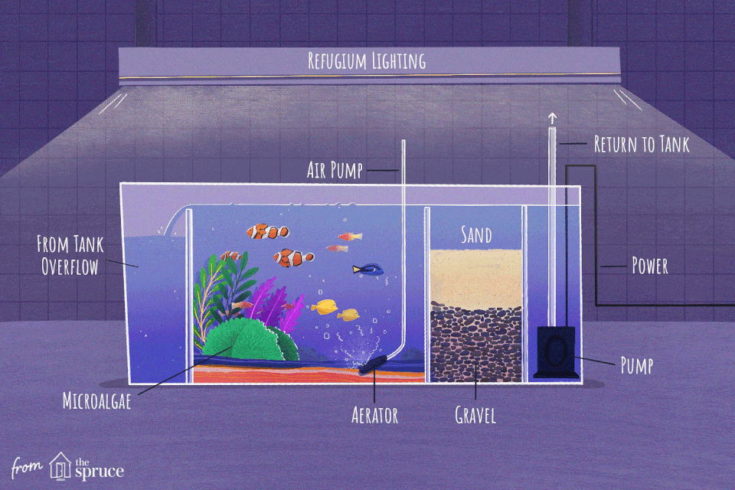
A refugium is defined as a “place of refuge” that can come in the form of an external box that lives out of sight in your aquarium cabinet, as a discreet hang-on-back unit, or in full view in the aquarium itself. Also, some aquarists create a mini refugium by using a dedicated box compartment in their sump or purchasing a small aquarium for the purpose.
Refugium Uses
Hobbyists use refugia for many different reasons:
- A facility for growing natural fish foods, such as copepods, which would not survive in the main tank.
- A place to grow algae that can work for you by extracting nitrates and waste from the tank water, helping to keep the water safe for your fish.
- A place to store live sand or refugium mud that absorbs nutrients from the water and helps to grow certain species of algae.
- A dark “cryptic zone” where live sponges can be grown as natural filters for reef tanks.
- Grow corals in a safe environment that’s well away from coral-eating fish species.
Inside the refugium environment, you can keep creatures that wouldn’t survive in the main tank or would detract from its aesthetic appeal. You can also cultivate organisms that help to filter and clean the aquarium water, boosting the efficiency of your biological filter system.
Variable Conditions
In some tanks, the water flow is restricted to suit the fish or creatures that live in the aquarium. Inside the separate environment of the refugium, the flow can be boosted, if necessary, to promote the growth of plants or improve biological filtration.
Also, the light cycle inside the refugium can be set to the opposite of that inside the main display tank. During the refugium’s “daylight” hours, plants extract acid-forming CO2 during photosynthesis, helping to keep the water pH more stable. Bright lighting inside the refugium can also be useful in encouraging the growth of useful species of algae that would be unsightly inside the main tank.
What Is An Aquarium Sump?
By definition, a sump is a reservoir or pit that acts as a drain or container for liquids and is generally the lowest point of a drainage or circulating system.
An aquarium sump is an extra tank that usually lives underneath the main display aquarium and is used to house equipment, such as filters, heaters, protein skimmers, and associated cabling and hoses.
The sump is also used to add water volume to the aquarium system, helping to keep the water clean and alleviating the problem of nitrate buildup. Most hobbyists prefer to use trickle filters with a sump so that the water passes through the filter tower before dropping down into the sump.
Commercially produced acrylic sumps are available, or you can simply recycle an old aquarium for the purpose.
What Are The Advantages Of Using A Sump?
One of the main advantages of using a sump is that it allows you to organize and consolidate multiple items of standard fish tank hardware all in one place. That makes maintaining your setup much easier and keeps what would otherwise be unsightly clutter out of sight so that it doesn’t detract from your aquarium display. If the sump is large enough, you can use it to add extra filter media, a UV sterilizer, or a filter sock.
You can also use a sump as a mechanism for the delivery of carefully dosed fish medication, plant fertilizer, top-off water, and the like to your system without the risk of disturbing your livestock. Problem fish can be temporarily housed in the sump, and you can use the space for growing frags for reef tanks, too.
A sump also maintains a stable waterline in the main tank and keeps the water surface free from contaminants. Also, if you run a system that has pipes coming out of the aquarium, carrying water to the filters and other equipment in the sump, the sump collects the water and prevents it from overflowing.
Is A Refugium The Same As A Sump?
So, it may sound as though a refugium is really just a kind of sump. However, there are several differences:
| Refugium | Sump |
| Can be used with saltwater, freshwater, and brackish tanks | Can be used with saltwater, freshwater, and brackish tanks |
| Multiple uses | Primarily an equipment storage facility |
| Can act as additional biological filter system | Contains filtration equipment |
| Relatively quiet operation | Relatively quiet operation |
| Can be used to house certain plants, live foods, macroalgae, etc | Allows customization of equipment setup |
| Planted refugia can help to stabilize the aquarium pH | Not suitable for housing plants due to lack of space and light |
| Lighting can run independently of the main tank. | No facility for lighting |
| Can be used to increase water volume in main tank | Can be used to increase water volume in main tank |
Best Of Both Worlds?
So, you can see that there are actually some very good reasons to keep both a refugium and a sump.
But do you place the refugium before the sump, or vice versa? That depends on your setup.
For example, if you have a display tank that relies very heavily on effective biological filtration, I would recommend installing the refugium downstream from the sump. That way, the water will be packed with nitrate but devoid of oxygen before it enters the refugium from the sump and biofilter.
However, if you have a saltwater reef aquarium, you may want to place the refugium before the sump. With that placement, all the yellowing compounds that the algae release in the refugium will be removed by the chemical filtration media in the sump before the water is pumped back into the main tank.
In Conclusion
Refugia and sumps can be used with freshwater, saltwater, and brackish tanks. Sumps are primarily used for the storage of items of system equipment and can allow hobbyists to customize their filtration setup. Refugia are a little more versatile and can be utilized for improving biological filtration, breeding live foods, growing plants, and more.
I hope you enjoyed our comparison guide to refugia and sumps. If there’s anything else you need to know, please put your questions in the comment box below, and don’t forget to share the article with your friends if you found it helpful.
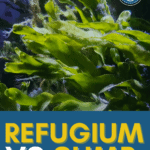
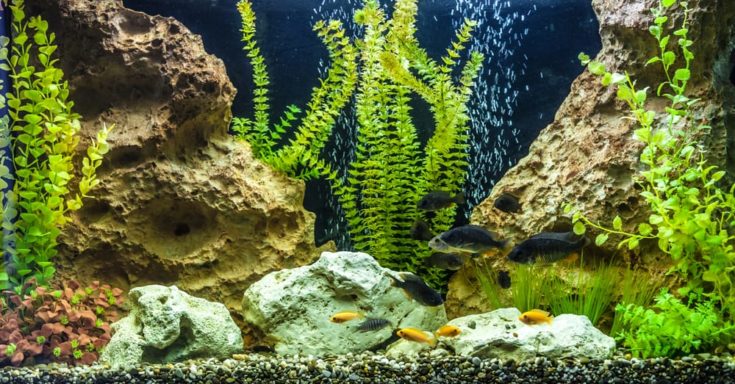
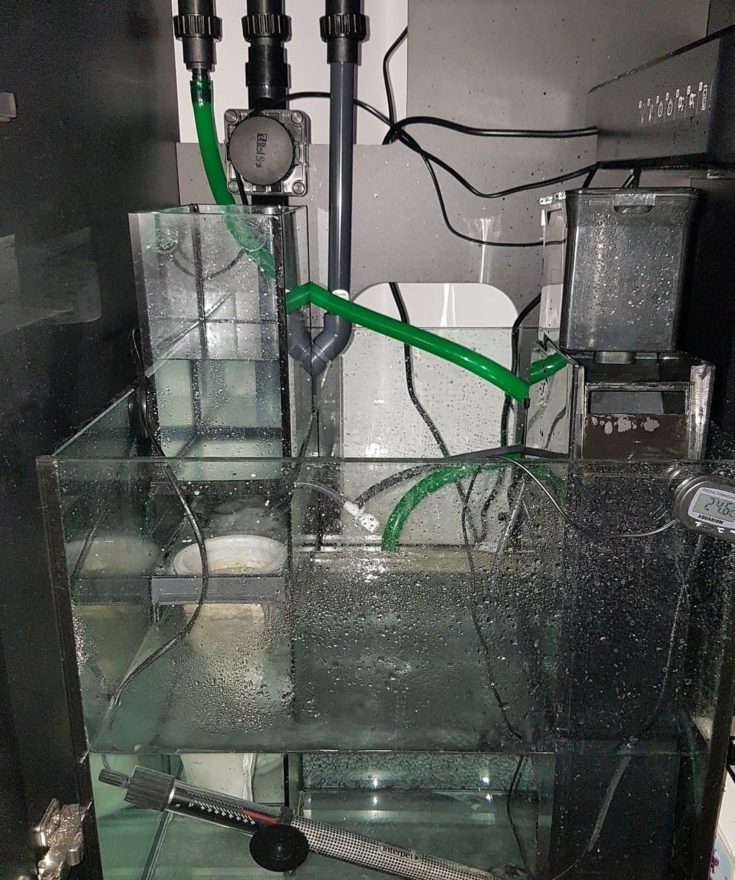
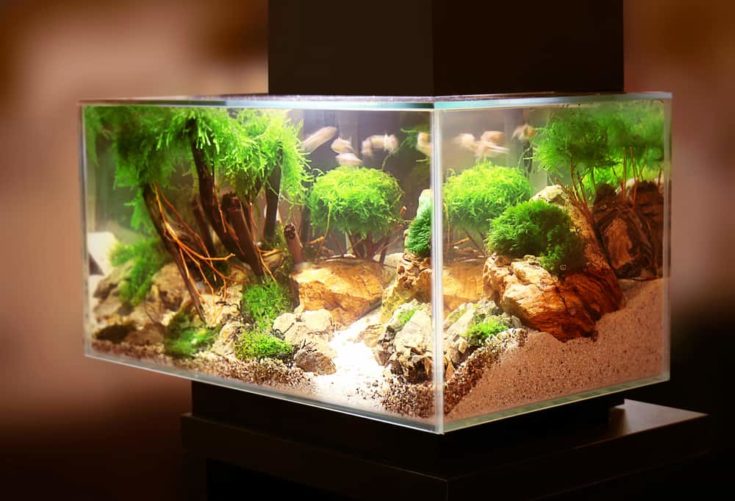
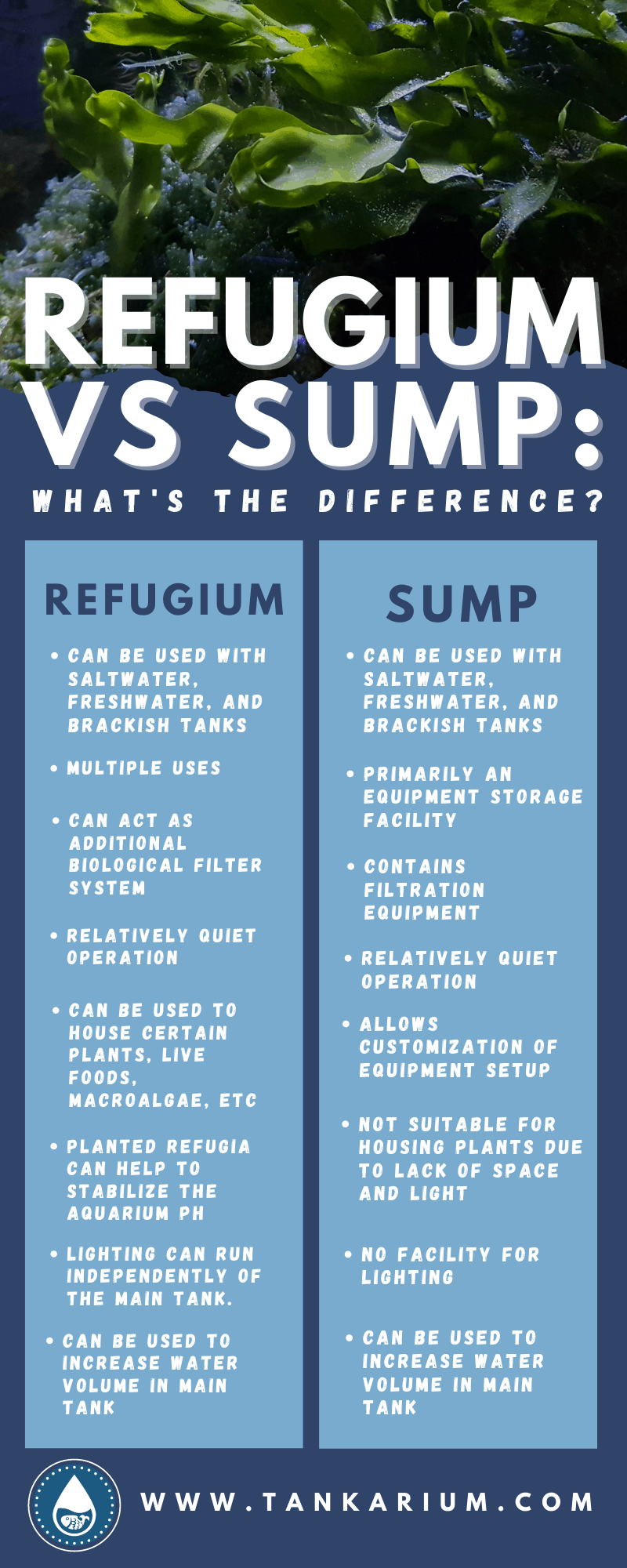
Thanks for very informative post. Although the sump takes a lot of work and additional costs to set up the best aquarium sump, it will be worth it in the end. 🙂
Im converting a reef tank to fresh. I want to have a tefuhium. Can you give me a few pointers as to how to start the refuhium. ? What plants. Ideally i would like the refugium, to control water quality as much as possible, and maybe add some food. Mainly a few angels and mixed Maybe shrimp crabs in refugium. Its a 200 gal tank w about 30 gal refugium